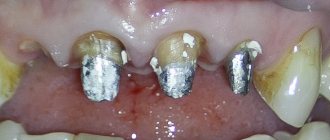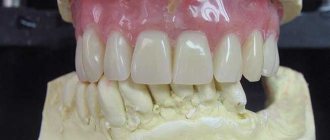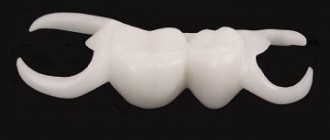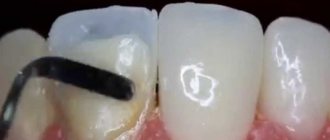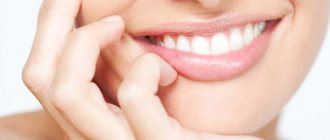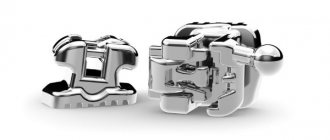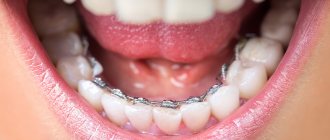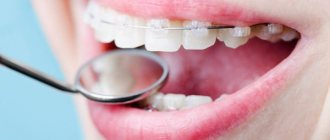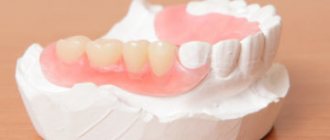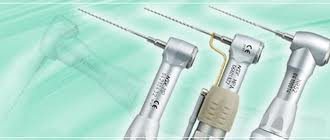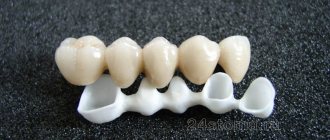What is a dental pin ↑
The pin is a special design whose appearance resembles a rod.
Photo: Dental pins
It is installed into the root of the tooth and provides additional support for restorative materials, which include crowns and fixed bridges.
The use of pins helps to preserve the tooth’s own viable root, the presence of which is an indispensable condition for the procedure. In addition, the cost of installing a pin is much cheaper than the prosthetic procedure.
Video: restoration with pins
Which is better: pin crowns or fillings?
Many patients prefer filling to crowns on a pin due to the affordable cost of treatment. But we must take into account that after the pulp is removed, the tooth becomes extremely fragile. If the scale of destruction is quite large, filling without overlap can lead to unpleasant consequences:
- Fracture below the gum line. In this case, the tooth must be removed.
- Secondary caries. Due to the shrinkage of the composite mass, gaps are formed between the restoration material and dental tissues, into which microbes can easily penetrate. As a result, the tooth is destroyed from the inside, which will also lead to removal.
Installing a pin crown will provide reliable protection for the remaining tissue and prevent the occurrence of such problems.
Application ↑
Being a fairly old invention, pins are widely used in the field of restorative dentistry. Today they are used for a number of procedures.
These include:
- dental prosthetics with fixed bridges. This is especially true if there is no possibility of attaching the prosthesis to adjacent teeth;
- restoration of a damaged tooth crown by building it up supported by a pin. They are used to strengthen teeth and prevent the formation of fractures using especially durable structures (titanium, metal, etc.);
- creation of complex combined structures for splinting teeth. Helps ensure stable fixation of mobile teeth during periodontitis;
- cleaning, removing moisture or medicinal treatment of dental canals, for which special paper points are used, which are sterile and highly hygroscopic.
Contraindications ↑
Contraindications for restorative procedures using dental pins include:
- diseases of the blood and nervous system;
- damage or inflammatory periodontal diseases;
- the presence of cysts and granulomas of the oral cavity;
- caries;
- curvature or obstruction of the root canals;
- low root length and wall thickness;
- absence of a tooth crown in the frontal region.
Before performing a dental procedure using pins, you should make sure in advance that there are no contraindications listed above.
A thorough medical examination will reveal the degree of resistance of the tooth root to the planned loads, and will also allow you to measure the thickness of their walls.
First of all, the selection of pins should be carried out by the attending physician. An experienced specialist will be able to assess the patient’s needs and choose the most suitable material for each individual case.
The selection of a particular variety is based on several factors:
- the degree of destruction of the tooth root relative to the gum.
- the degree of upcoming load on the object being restored and the thickness of its walls.
- maximum possible pin installation depth.
- service life of the installed structure.
Today, there is a wide selection of dental posts, each of which has a number of specific advantages. So by what criteria can these structures be classified?
By material
Like a regular filling, a dental post is made from a variety of materials. They all differ from each other in purpose and methods of fixation, as well as in terms of strength and elasticity.
Anchor pins
Photo: Anchor pins
They are a fairly voluminous structure made of alloys based on stainless steel, titanium or precious metals. Designed for complete restoration of extensive destruction of the dental crown, but require good condition of the root canals.
Metal
The most popular are silver metal pins. Designed to restore large areas of destruction and strengthen tooth crowns.
Their advantages include non-corrosion, good visualization on X-rays and the absence of reactions with the human body.
Carbon fiber
The advantage of carbon fiber pins is the high degree of elasticity of the material, close to that of the dentin layer. They prevent tooth fractures in the root area and significantly strengthen them.
Fiberglass
Photo: Fiberglass pins
Being a relatively new material for making pins, fiberglass is very popular due to its elasticity and inability to cause allergic reactions.
Fiberglass structures are easily removed when secondary treatment is necessary and significantly reduce the load on the tooth root.
Video: dental restoration using pins
Ceramic
Designed to strengthen teeth after treatment, as well as restore them in case of significant damage to the crown.
The advantage of ceramics is its aesthetics, as a result of which there is no risk of it showing through the tooth.
Also, if necessary, it can be removed without compromising the integrity of the tooth.
How to cure thrush on the tongue in adults? Recommendations in this article.
Parapulpal
They are structures made of a metal stainless alloy with a polymer coating. Unlike previous designs, parapulpal pins serve as support for the main prosthetic structure and are not installed in the tooth cavity.
Stump inlays
Photo: Stump tab
They are the most reliable designs for tooth restoration procedures. It is made from an individual impression of the patient’s damaged tooth for subsequent fixation of an artificial crown on it.
Gutta-percha
These are factory rods of various sizes, designed for installation and fixation in the root canal using a composite.
Despite the affordable cost of this material, it is also not durable.
Photo: Gutta-percha points
By elasticity
According to elasticity indicators, elastic and inelastic pins are distinguished.
Elastic
The main advantage of elastic pins is the protection of the restored tooth structure from peri-root refraction.
Inelastic
Excellent support for the created restorative structure, including bridges.
By type of fixation
Depending on the type of fixation, dental pins are either passive or active.
Passive pins are used to strengthen teeth after treatment. To do this, they are fixed in the root canal cavity using a special substance.
Active pins are used to restore completely damaged teeth.
This pin is the most reliable method of fastening. It is a solid rod fixed in dentin by screwing into the bone tissue of the tooth.
Alternative options
Dentists consider anchor pins obsolete; today, their alternatives are materials such as carbon fiber, ceramics, gutta-percha, etc. Fiberglass-based structures are very popular, which have a number of advantages compared to anchor pins:
- materials do not cause allergies in the patient;
- do not cause destruction of the walls of the root canal over time;
- if necessary, they can be easily removed and reinstalled (this is very important when treating dental diseases that have arisen).
The only advantage of anchor pins compared to other types of construction is their low price.
It is important to remember that only a good specialist can determine the type of structure required and install it. Otherwise, you should not count on a positive result.
Installation steps ↑
Installation is carried out in several stages:
- Thorough cleaning of the root canal.
- Insertion of a pin rod into the open channel. An important condition at this stage is to ensure optimal fixation of the rod by inserting it into the bone tissue.
- Sealing the structure.
- Dental prosthetics using a crown or artificial prosthesis.
- Testing the reliability of fastening the structure based on the patient’s sensations. If necessary, it can be adjusted by grinding.
Read also: Treatment of the trigeminal nerve
Anchor pin installation procedure
To begin with, the patient must be examined by a doctor to determine the degree of damage to the tooth and the possibility of installing such a structure. Then the root canal is thoroughly sealed (application of filling material). At the next stage, the dentist determines the type of structure (active or passive). When a tooth is filled, a passive pin is most often installed; it is secured with cement mortar.
The installation procedure of the anchor structure takes place in several stages:
- Cleaning the root canal and introducing gutta-percha.
- Insertion of a pin into the resulting cavity, followed by an x-ray (it shows whether the rod is installed correctly).
- Applying a cement material to the walls to help secure the structure.
- Grinding and turning of the tooth, preparation for the prosthetic procedure.
- Installation of a crown or prosthesis to restore the anatomical shape of the tooth.
- Testing the installed structure for strength, performing grinding if necessary.
The whole procedure takes no more than an hour . Since the dental nerve is first removed, anesthesia is not required when installing the anchor rod. This design can last more than 10 years with proper care.
Disadvantages of the method ↑
Like any intervention in the human body, the procedure for restoring damaged teeth using pins has its drawbacks.
These include:
- development of complications, as well as intensive destruction of the restored tooth. It is the result of errors made during the manufacturing process of the pins;
- development of an allergic reaction up to rejection of the pin structure due to its incompatibility with the patient’s body;
- secondary tooth destruction with the inability to restore it again. It is the result of thinning of the tooth walls, which are under intense stress due to the pin located inside;
- removal of the tooth root if it is necessary to remove the pin due to its strong fixation during installation.
Installation prices largely depend on the material from which it is made and start from 700 rubles.
Advantages and disadvantages of titanium pins
| Pros: | Minuses: |
|
|
What types of dental pins are there?
Externally, dental pins resemble a rod, which is fixed in the root canals, after which teeth are built up. A pin is placed in the tooth if its outer part is preserved by at least 20%. types of structures are distinguished :
- Anchor, made of metals - titanium, gold alloys, palladium or platinum, stainless steel.
- Fiberglass ones, which have good aesthetic characteristics, do not show through the crown, and therefore are used on the front teeth.
- Carbon fiber, elastic, but at the same time characterized by high strength and the ability to distribute the load evenly in the channel.
Anchor pins are most often used in dentistry.
Another classification is based on the way the pin is fixed in the tooth root:
- Active structures are threaded and screwed into bone tissue. Active fixation is used in cases of severe tooth decay, but only when the root canals have not been expanded.
- Passive structures involve the use of cement, with which they are fixed in the canal cavity. This technology is used to strengthen a tooth after treatment, which leaves a hole in the tooth that needs to be closed with a cementitious solution.
Pins are also distinguished by shape.
Finally, designs vary in channel shape :
- Screw.
- Cylindrical.
- Conical.
- Cylindrical.
When choosing the most suitable design for a particular patient, the doctor focuses on the following parameters :
- how badly the tooth is damaged;
- how much the root is destroyed, how deep the pin can be installed;
- what will be the load on the root, will the tooth serve as a support for the prosthesis;
- patient's health condition.
Expert opinion. Dentist Ovdienko O.Yu. : “In recent years, preference has been given to non-metallic structures, since, firstly, they benefit from an aesthetic point of view, and secondly, they are able to fill the entire channel. At the same time, they are in no way inferior to metal ones in terms of strength. In addition, non-metallic pins have flexibility, which is very important for the functionality and durability of the structure: if a pin is installed that cannot bend, the main pressure is on the channel wall, which can crack.”
What is a pin in dentistry
This is a structure in the form of a rod, which is fixed in the root canal of a destroyed tooth. It serves as an element that ensures reliable adhesion of the root system to the composite material or artificial crown. The use of such a pin allows you to restore the crown part of the tooth in the presence of a living root in satisfactory condition. Before installing such a structure, the doctor must take into account the following points:
- degree of crown destruction and the possibility of fixing the rod in the root canal,
- expected load on the tooth,
- the depth to which the rod can be immersed in the channel.
Intracanal pins are different, they are made from various materials, and the choice of a specific model directly depends on the characteristics of the clinical picture. A separate niche is occupied by anchor models - rod clamps, which can be brass, titanium, made of an alloy of gold, platinum or stainless steel. They are the most durable and allow the restoration of an almost completely destroyed tooth, ensuring long-term results, including in the area of chewing molars.
Indications and contraindications
Destruction of the coronal part by more than half is an indication for the installation of pins.
Why are pins needed? Indications for their use are:
- tooth decay is more than half;
- lack of crown;
- the need to create support for the installation of prostheses.
There is also a list of contraindications :
- absence of a tooth crown belonging to the frontal region;
- blood diseases that are accompanied by clotting disorders;
- periodontal damage and inflammation;
- caries, which must be eliminated before the pin is installed;
- the presence of granulomas and cysts in the oral cavity;
- short root, as well as thin root walls (minimum 2 mm).
How to place a pin in a tooth?
Installation occurs in accordance with the following algorithm :
- Studying x-rays of the tooth root to assess its length, diameter, and direction of canal inclination.
- Cleaning the root canals - first with minimum-sized drills at low speeds to avoid cracks and perforation of the root.
This is a description of the general technology and sequence of actions, however, in each specific case it may differ slightly, since teeth on pins made of different materials are made using different techniques.
Approximate prices
How much does it cost to install a tooth on a pin? The answer to this question depends, first of all, on the type of structure, on the material used, on the degree of preservation of the tooth and on the amount of work required for its restoration. The average cost of teeth on pins in Moscow clinics is as follows:
- anchor (usually titanium) pin in a tooth - from 500 rubles. ($7.5);
- fiberglass - from 2000 rub. ($31);
- stump inlay - from 10 thousand ($153) (cobalt-chromium alloy) to 27,000 ($415) (ceramics).
The price indicated is for the pin only; the cost of tooth restoration performed using it will be different: on average from 3,000 ($46) to 15,000 rubles ($230). In addition, to this amount it is necessary to add the cost of making a crown or building teeth with composites - from 3 to 20 thousand rubles ($46-307).
Cost of restoring a tooth with an anchor pin
- titanium pin - about 500 rubles;
- titanium with gold plated - about 800 rubles;
- tooth extension with photopolymer – from 2,500 rubles;
- metal-ceramic crown – from 10,000 rubles.
Installing an anchor pin makes it possible to re-mold the damaged tooth and preserve the remaining tissue. But is it better to choose a cheap metal rod or a more expensive fiberglass retainer? Only your attending physician can answer this question, having assessed all the nuances of the clinical picture.
If you are looking for a dentist or a suitable clinic, then use the search engine on our website.
Rehabilitation
Despite the fact that the operation of restoring a tooth with a pin is considered ordinary in modern dentistry, it has a postoperative period, during which the following rules :
- take medications prescribed by your doctor (for example, antibiotics);
- do not injure the mucous membrane with food, consume it in a pureed state;
- brush your teeth at least twice a day, but very carefully, with a soft brush, to avoid injury;
- do not use toothpicks, especially in the area where restoration was carried out.
FAQ
Dental restoration using pin structures is a very common procedure. However, for those who encounter it for the first time, it raises many questions. We will give answers to the most common among them.
— Does it hurt to install a pin in a tooth?
The installation procedure itself is performed under local anesthesia, so it is absolutely painless. Unpleasant sensations and pain may appear after the anesthesia wears off, but they should not be long-lasting.
— What to do if a tooth with a pin hurts after its installation?
When installing the pin, the doctor touches the soft tissue, so pain after the anesthesia wears off is normal. Painful sensations are also natural if a nerve has been removed. But sometimes pain occurs as a result of a medical error - for example, if the rod went too deep and rested on the bone, if the root canals were not completely sealed, if damage was caused to their walls, and for other reasons. In addition, due to poor-quality processing, inflammation can develop, and sometimes a fistula can form. If the pain does not go away within a few days or gets worse, you should consult a doctor.
— Can an allergy occur to the pin structure?
Most often, an allergic reaction may occur if a metal rod is installed. It is accompanied by swelling, redness, itching, pain, and the development of stomatitis. These symptoms may appear immediately after surgery or some time later; in any case, they require contacting a doctor and, if an allergy is confirmed, replacing the design.
— Is it possible to do an MRI if there are pins in the teeth?
Metal can indeed affect the course of the MRI procedure and its results. Firstly, under the influence of a magnetic field they heat up and can move. Secondly, metal distorts the magnetic field of the device, so the image may turn out unclear. This is not about all designs; In addition, many clinics install modern equipment that does not affect ferromagnetic alloys in any way. In any case, before the procedure you need to inform your doctor about the presence of metal pins.
— What to do if the tooth on the pin is loose?
First of all, it is necessary to find out the cause by taking an x-ray. Tooth mobility may be due, for example, to the fact that the pin or crown has become cemented. It occurs both with a root crack and with periodontitis changes in the area of the restored tooth. Only a doctor can plan treatment after examination.
— What to do if a tooth with a pin falls out?
A crown installed on a rod can fall off for two reasons: if the remaining walls of the tooth rot and if the fixation was not done well enough. It is necessary to contact a dentist as soon as possible: it is possible that it will be possible to restore the crown without re-treatment of the tooth. Another reason for crown loss is significant destruction of hard tissue. In this case, it is better to refuse re-installation of the pin and give preference to implantation.
— Why did the unpleasant smell appear from under the crown?
If there is an unpleasant odor coming from under the crown, the tooth may have begun to rot.
The smell appears when the remaining tooth begins to rot. Other manifestations of decay include food getting stuck under the crown and the tooth turning black. The only way to combat this is to consult a doctor who will cure the tooth and install a new structure.
— How can you remove a pin from a tooth?
Removal of the pin may be necessary in the following cases:
- repeated treatment is necessary (for example, if a pathological process develops near the apex of the tooth root);
- the installation was performed poorly, the rod was placed too deep;
- the material from which the structure is made causes allergies;
- before implantation.
The removal procedure is usually painless. The doctor removes crowns, destroys fillings, removes artificial structures and destroys cement using ultrasound. After checking the patency of the root canals, the dentist, if necessary, installs a new structure according to the standard algorithm.
How to make a tooth on a pin
The pin installation process includes the following steps:
- Preliminary examination of the oral cavity, deciding on the advisability of using a pin, choosing the appropriate material.
- Sanitation of the oral cavity.
- Tooth preparation: unfilling, depulping.
- Installation of the pin into the canal. If glass or carbon fiber was used, the excess material is cut off and the rod is fixed using a special composite.
- Restoring the natural appearance of the crown.
The operation is performed on a “mortified” tooth under local anesthesia, so it is completely painless. Discomfort is mainly associated with nervous excitement and anticipation of pain.
In truth, the process of installing pins looks quite terrifying, as many people who decide to study this issue and look at photos on the Internet are convinced of. But you shouldn’t refuse the necessary operation just because of unpleasant pictures: the dentist will still have to watch everything that happens, not you.
The nuances of using an anchor pin in dentistry to restore a damaged tooth
Over time and in the absence of proper care, teeth begin to deteriorate. Previously, when there was severe destruction, the dentist recommended removing the problematic unit.
Using an anchor is the best alternative to extraction. This modern method allows you to restore and preserve an organ even with significant damage.
The content of the article:
General overview
Elements of the dentition are large in size and can withstand high loads, so they must be stable, otherwise they are subject to serious damage. When restoring severely damaged teeth, the filling or crown simply will not hold.
The retainer is a special design that acts as a support for installing a crown or filling. Its active use in dentistry is due to the possibility of obtaining good results at low cost.
There are several types of retainers in dentistry. The anchor type is used to completely restore a unit in case of severe destruction.
The only drawback of this restoration method is that for a quality installation, the roots must be in good condition.
The principle of restoration is that the rod is installed in the root, then covered with a crown or photopolymer materials.
This method allows you to restore not only the appearance of the organ, but also ensure its full functions. Externally, the restored element is no different from an anatomical organ.
Types of products
Standard anchor products are metal. Gold, brass, titanium, stainless steel and other alloys are used for their manufacture. The durability of the restoration will depend on the quality of the material from which it was made.
Forms of clamps
The shape of the anchor pin is selected individually depending on the clinical case. The dentist is based on the number of roots, the nature of the dental canal, and the depth to which the retainer should be immersed.
- Conical. The base of the clamp has a larger diameter and becomes sharper towards the end.
- Cylindrical. They have an equal diameter along the entire length. Suitable for wide channels.
- Cylindrical-conical. They have a wider base, then taper, but do not point at the end.
Features depending on installation
Dentists use two types of installation:
- Active. Can have any shape. Its peculiarity is the presence of threads. Fixation in the hard root tissue occurs by screwing into the prepared cavity.
This method is dangerous because pressure may cause the root wall to burst. This will result in the need for complete removal.
- Passive. Fixation is carried out through the use of cement, with which the product is fixed in the canal of the problem organ. The structure may fall out due to the weakening of the cement.
The risk of root destruction is the main reason for the frequent use of the passive installation method. Modern materials make it possible to fix the rod at the root for a long time.
Modern methods of artistic restoration of teeth and indications for implementation.
Come here if you are interested in the characteristics of a ceramic tooth inlay.
Kinds
Anchor
Consist of gold-platinum or palladium alloy. There are active and passive:
- active - have a thread and are screwed into the root of the tooth, but such an installation can cause serious complications, for example, the formation of cracks;
- passive - fixed in a more gentle way (due to cement).
Titanium
This is a budget option for a metal anchor pin. Titanium is a durable and hypoallergenic material, well suited for strengthening severely damaged molars.
However, all metal rods have many disadvantages, for example, they are not suitable for the restoration of anterior teeth, they create increased pressure on the root, and they are difficult to remove from the canal.
Fiberglass
A more advanced type of dental core. Made from continuous glass fibers. They provide uniform mechanical load, and they are also completely transparent and therefore suitable for front teeth. Fiberglass retainers do not oxidize, do not rust, and are easily removed from the channel.
Carbon fiber
Elastic and durable pins, which in their structure are close to the natural bone tissue of the tooth. They create rational force tension in the root canal and prevent root and crown fractures. This is a universal and most popular type of clamp.
Parapulpal
These are rod structures made of a metal alloy, coated with a polymer mass. They are not fixed into the dental cavity, but are used mainly for additional retention (holding, strengthening) of the filling. Rarely used.
Indications and contraindications
The dentist installs an anchor for the following indications:
Prerequisites for installation
An anchor can only be installed if the patient:
- hard tissues are preserved at a height of 2-3 mm from the gum line;
- an x-ray confirms that the root walls are preserved, the thickness should be at least 2 mm;
- a filling was placed in the canal, which can be partially unsealed. To install, you will need to drill out about 2/3 of the seal.
The dentist will not be able to install the retainer in the following cases:
- chronic inflammatory gum diseases;
- obstruction of the dental canal;
- any neoplasms in the area of the tooth root and gums.
How to install a fiberglass pin
The procedure consists of several stages:
- X-ray diagnostics. To correctly place a fiberglass pin, a specialist must find out the dimensions of the tooth root, the direction of its slope, and identify all existing bends and narrowings.
- Expansion of the root canal using drills of different diameters.
- Root canal disinfection.
- Trying on a fiberglass pin. Mandatory condition: the structure should not be immersed in the canal less than the height of the tooth crown.
- Adhesive root canal preparation. It is degreased with alcohol and treated with phosphoric acid for at least two minutes. Then washed with water and dried.
- Preparation of the pin structure. To securely fix fiberglass pins, they are also treated with alcohol, dried, then sandblasted, etched with phosphoric acid, adhesive and polymerized.
- Root canal treatment. The canal walls are coated with bonding agent, dried and polymerized with a lamp. A thin layer of dual-cure cement is then applied. The rod itself is covered with the same material and placed in the channel. Excess cement is removed.
- Fixation of fiberglass pin by light polymerization.
- Restoration of the coronal part using composite materials or prosthesis.
Installation steps
Installation can only be performed by a professional dentist. The procedure is carried out in several stages.
The complexity and duration depend on the degree of tooth destruction, the condition of the canals and the physiological characteristics of the patient.
Preparatory stage
The procedure is not directly related to installation, but is an essential step. The service life of the restored tooth depends on the quality of its implementation:
- Isolation of neighboring units . Allows you to create a field for work and prevents damage to healthy organs.
- Removal of hard tissues affected by caries. To prevent its spread after the procedure.
- Disinfection of the surgical field. The procedure is necessary to avoid the development of an inflammatory or infectious process after manipulation.
- Preparation of the dental canal. If necessary, it is expanded. Next they are treated with antiseptic agents.
The basics of competent preparation of teeth for crown prosthetics - mandatory and additional manipulations.
This publication contains all the most important things about installing compositors.
At this stage, the dentist fixes the rod in the dental canal. Before installing the main element, it is recommended to use a temporary one.
After installation, the patient is given an x-ray to ensure that the element is in the correct direction and is immersed to the required depth. Next, the temporary product is removed and installation of the permanent one begins.
- The active pin is carefully screwed into the root canal. The dentist must feel the process, otherwise it may damage the root walls.
Passive products are less demanding in terms of accuracy of insertion, but it is worth paying attention to high-quality fastening.
Special cement mortars are used for fixation. Part of the rod should rise above the gum line; the crown will be fixed on it.
During the procedure, the patient may feel pain, so all manipulations are performed under local anesthesia. Despite this, the patient may feel discomfort during the procedure.
In the video, see the principle of installing the stump structure.
Advantages and disadvantages
Before deciding to use the anchor pin method of restoring a tooth, you should familiarize yourself with its main advantages and disadvantages.
Advantages
- High strength. Metal retainers reliably hold the part of the tooth being restored and withstand high loads during chewing.
- Low cost. A stainless steel product costs about 90 rubles.
- High recovery rate. The entire recovery procedure lasts no more than an hour in complex cases.
- Possibility of installing a prosthesis . The anchor fixator is suitable for use as a basis for installing microprostheses.
Flaws
- Possibility of root damage during installation. As a result, the tooth will have to be removed.
- Corrosion. Since anchors are made from metal alloys, they can deteriorate over time.
- Aesthetics. The retainer is different in color from the tooth enamel and can be seen through.
- Difficult to remove. Since the element is rigidly fixed in the dental canal, attempts to remove it can lead to perforation of the dental roots.
Advantages and disadvantages
Main advantages:
- they cannot be broken;
- affordable price;
- service life is about 10 years.
But many doctors believe that anchors are outdated and do not meet modern requirements.
Flaws:
- low connection strength;
- poor aesthetics - metal pins are not suitable for restoration of anterior teeth;
- high risk of root fracture when installing a metal rod;
- difficulties in removing the pin from the canal (if repeated endodontic treatment is required);
- metal corrosion may occur.
An alternative to anchor structures are flexible fiberglass pins, which are made from transparent glass fibers. They are considered more advanced and are indicated even for frontal teeth.
